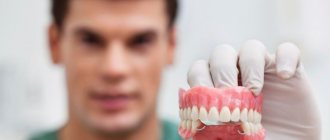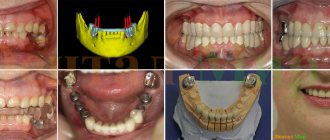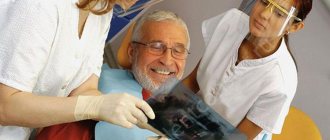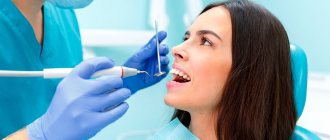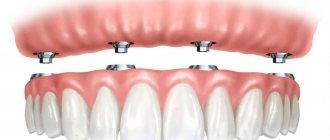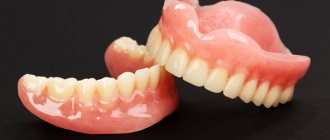The prosthetic procedure is the restoration of damaged or lost teeth, allowing not only to get a beautiful smile, but also to fully realize chewing functions. Various types of dental prosthetics used today make it possible to restore one tooth, several, and even the entire dentition.
First of all, from the point of view of patient convenience, dentures can be removable or non-removable. If it is necessary to replace one or more teeth, dentures are often permanent. In case of complete loss of dentition, previously only removable dentures were used, but today it is possible to install fixed dentures on implants.
Denture: what is it?
Dental structures inserted in place of lost teeth, partially or completely replacing the dentition, are called dentures.
They can be made from a variety of materials, can be attached to the jaw in a variety of ways, and vary in cost. Well-chosen and professionally installed dentures will return a beautiful, charming smile and solve the problem of chewing food. The use of innovative technologies and materials gives modern dentures undeniable advantages:
- comfortable to wear
- Microorganisms do not multiply on them
- light weight
- closes less of the mouth
- look natural
- reliable fixation, all models can be left overnight
Ceramic crowns for teeth
Metal-free crowns are deservedly recognized as the most aesthetic: they are extremely difficult to distinguish from natural teeth, even if the gum tissue becomes thinner, the prosthesis remains invisible and looks natural. In dentistry, several types of metal-free dental crowns are used:
- Porcelain or all-ceramic. They are made according to a personal impression from pressed material without adding other components.
- Mixed (zirconium dioxide and ceramics). They are stronger than the previous type of prosthesis, have high light transmittance and do not cause allergies.
- Mixed (aluminum oxide and ceramics). The designs are made of translucent hypoallergenic material, which is comfortable to wear and resistant to temperature changes.
All ceramic products are biologically compatible with mucous membranes and do not tend to cause allergic reactions. Other advantages of the designs include:
- light weight (a crown can be installed even on weakened teeth);
- immunity of ceramics to dyes;
- the need for minimal tooth grinding before ceramic prosthetics.
The disadvantages of this method of prosthetics include the relatively high cost of the products, as well as their fragility. Ceramic structures are not designed for significant chewing loads, which is why they are more often used for prosthetics of the upper incisors.
If you properly care for ceramic products, they will last from 10 to 15 years. At the same time, the prosthetic structure is not susceptible to caries and does not accumulate plaque.
Which dentures are best to install?
Today, dentists can offer a variety of designs from various materials; in addition, dentures can be made in both fixed and removable versions.
The choice of design and material for the manufacture of prostheses suitable for the patient is chosen by the orthopedic surgeon, based on individual indications, the presence of allergic reactions to prosthetic materials and other details revealed during examination and anamnesis.
How long ago were the teeth removed?
Many people are interested in the question of when they can start dental prosthetics after extraction. It’s not easy to answer unequivocally - it all depends on individual characteristics. The average time frame is after 3–6 months, during which time you can undergo a course of treatment if necessary according to indications.
Selection of implant system
To compare dental implants, two main characteristics are taken: the cost of the product and the time frame for survival.
If we talk about economy and premium class implants, the former are inferior to the latter in terms of engraftment speed. This significantly reduces the time required for engraftment, and therefore the entire course of treatment.
Nobel Biocare, Osstem (Korea), AB, and Xive also occupy leading positions in the global market for implantation systems.
Choosing an implantation technique
Among the types of dental implantation that exist today, the most suitable one for a particular patient is selected, taking into account his individual characteristics, wishes and capabilities.
- Intraosseous implantation The implant is fixed directly into the bone tissue. Currently, the technique is recognized as the most effective of all known.
- One-stage implantation One visit is enough to install the implant and temporary crown: this is a type of classic intraosseous implantation, carried out in one stage
From several methods known in modern dentistry, the attending physician will recommend choosing the one that best suits the indications for each patient. Moreover, it is necessary to take into account, in addition to individual characteristics, indications and contraindications for the use of a particular method in each specific situation.
Metal crowns
These are the predecessors of all other types of dentures. This type of prosthesis is indicated for installation only on chewing teeth, since the structures are noticeable on the front teeth. Metal crowns are made of steel, titanium, platinum, and gold. Alloys containing cobalt, chromium, and silver are also in demand.
In laboratory conditions, stamped or cast products with spraying are prepared for patients. Standard structures take on the desired shape as work progresses. Individual production of the cap guarantees maximum adherence to the tissues, which eliminates rapid abrasion of the material and the spread of bacteria under the prosthesis.
Among the advantages of such products, it is worth noting their exceptional strength (due to the plasticity of the material, a crown made of this type of material does not crack and does not wear out for a long time). However, metal dentures are extremely unaesthetic, can cause allergies, and are difficult to fit on a tooth.
In addition, when using metal prosthetics, it is worth considering that crowns made from several types of metal cannot be used at once. If the patient already has a steel structure in his mouth, in the future he will have to fix crowns only from this material. Otherwise, the patient may develop galvanic syndrome, which is manifested by a burning sensation in the mouth and a “metallic” taste.
Types of prosthetics
Traditionally, orthopedic dentists work using two methods of dentition restoration:
- therapeutic recovery
- dental prosthetics
When restoring the dentition, the orthopedist tries to preserve the original shape of the tooth as much as possible; this is possible when part of a tooth is lost. For this purpose, two methods are used - a dental inlay and the installation of a pin, which serves as the basis for restoring teeth.
Today there are quite a lot of dentures in use, which can differ greatly from each other. To have an idea about them, you should familiarize yourself with the main types of such prostheses.
Partially removable dentures
Instead of missing one, two or more teeth, removable dentures are inserted, which are indicated if:
- premolars and molars are lost; incisors and canines
- there is a defect in the smile area
- temporary dentures needed
Fixed dentures
Currently, there are 3 types of fixed dentures and bridges. The installation of such dentures is done “forever”, and they are fixed in place for the entire time of wearing. They are distinguished by great strength and reliability, even when compared with the most expensive removable dentures.
Fully removable
This type of dentures is called “false jaws.” During such dental prosthetics, an individual impression is first made, and then the dentures are made from special acrylic, nylon and acry-free.
This type of denture is recommended for those patients who are missing molars or need to have them removed. Sometimes patients are recommended to use a special gel for fixation, which prevents the denture from moving even during chewing, thereby preventing injury to the gums.
Removable dentures for complete absence of teeth
Absolute edentia is the loss of one or two complete rows of teeth. The issue can only be resolved by inserting removable dentures or implantation. In the second case, the effect is long-term, the patient feels more comfortable, and externally, the crowns on implants look more attractive.
However, you need to know that in 90% or more cases, when teeth have been lost for a long time, the bones atrophy due to the lack of regular chewing load. In this option, the issue of implantation without bone grafting cannot be resolved. Doctors use one-stage techniques that do not require an increase in the volume of bone tissue, as well as a method where prosthetics are performed on the third day.
Dentures for partially missing teeth
If the patient has one, two or several of his teeth left in the oral cavity, then the dentures rest on them and on the gums. This method allows you to securely secure the inserted prosthesis and distribute the load more evenly.
Dental structures of a removable type do not provide for a long period of use. The reasons for this are their inconvenience and lack of aesthetics. However, the main reason is that their fixation on the gums and supporting living teeth ends up with them bearing the main load when eating. The jawbone does not experience pressure, atrophies and sags. As a result, the removable denture will have to be replaced.
Acrylic (Plastic) dentures
Affordable and without contraindications, acrylic prostheses are the most common today. Another advantage of such structures is that there is no need to grind the teeth before installation: they are secured with special hooks.
Their use is justified if it is necessary to temporarily close the space available in the dentition due to missing teeth while a permanent dental prosthesis is being prepared. The second option when these prostheses are needed is engraftment during implantation.
Removable dentures made of nylon
Nylon is widely used for the manufacture of removable structures. The “suction” method is used for fastening, and the elasticity and resistance to stress makes such prostheses in demand among patients. Suitable for allergy sufferers.
Removable dentures “Acry-free”
Dental prostheses made from acry-free, a polymer material that does not contain acrylic, are becoming increasingly popular. It has sufficient elasticity and softness, and therefore prostheses made from it do not damage the mucous membranes. High resistance to mechanical damage allows you to wear them for up to ten years. In addition, Acry-free removable structures look quite attractive: the translucent material makes dentures less noticeable. They are ideal for allergy sufferers because they do not contain any metal elements and do not cause negative reactions.
Clasp dentures
The German word “Bugel” (arch) gives its name to partial dentures, which are an expensive, complex removable system. Clasp dentures are convenient and reliable to use. They compare favorably with their plastic counterparts in that they ensure uniform distribution of pressure on the gums and remaining teeth, while acrylic (plastic) ones load the gums and are only held in place by the teeth.
New generation of dentures without palate
The use of removable dentures has been practiced for many years, but modern models have a number of significant differences that make them more comfortable. The materials used to make the old type of structures made them rigid, while they covered most of the palate, which often caused vomiting. Today there are no such problems with dentures.
The modern market offers removable “sandwich” dentures for teeth that are fixed to the gums and held in place due to their own shape, without the use of fixing gels or adhesives. Such dental prosthetics solves all problems: no negative consequences such as vomiting or distortion of the taste of food; the appearance and quality of everyday life changes for the better.
Removable dentures on implants
Implants are titanium structures that are implanted into bone tissue and perform the function of a tooth root. They are indicated if there is nothing left of the teeth, not even the root. After engraftment, a prosthesis is attached to them, or a crown is put on.
- Screw-retained dentures. The crown is secured to the implant using a screw. If necessary, it can be removed
- With cement fixation. The crown is attached to the implant using a special aba that secures it and prevents it from being removed. This technique is more often used for prosthetic teeth that are visible when a person smiles.
- All-on-4. Four implants are implanted into the bone at different angles, after which a bridge-like structure is installed on them. Almost an analogue of this method can be the implantation of six implants (All-on-6), on which a bridge is placed. With such dental prosthetics, the load during chewing is distributed more evenly. This technique is applicable even when the bone tissue has significantly atrophied
- Dental prostheses for one-stage (basal) implantation. No major surgical intervention is required; implants are implanted into deep-lying layers of bone, making it possible to install prostheses in severely atrophied tissue. This technique allows for the installation of a crown.
- Prostheses for 2-stage implantation with delayed loading: several months (three to four, or even six months) pass before the installation of crowns after implantation. During this time, crowns are placed, which are subsequently replaced with permanent ones.
How to choose a good doctor
Finding a doctor who will restore chewing functions is a responsible task. The qualifications of a specialist directly affect the quality of the work performed, the durability of the structure and the impressions after visiting the doctor. A doctor must combine a master of his craft and a good psychologist in one person. Many people are afraid to go to the dentist, so to create a comfortable environment for the patient, the dentist must be friendly, not fuss, and explain the stages of work. Then your visit will leave only pleasant impressions.
A professional must know: how they are made, from what material removable and permanent dentures are made, and understand the types of fasteners with classification.
The most proven way to find a dentist is to collect reviews from friends. You can also use comments about specialists and clinics involved in bite correction from the Internet. For many years, the Dentika dental center has received only positive reviews from its visitors. The main goal is to make the reception pleasant, high-quality, person-oriented with a mandatory personal approach (to bring joy and health to every patient who comes to us).
At your appointment, you can ask the doctor to show all types of modern materials for high-quality complete dental prosthetics.
Features and types of dental prosthetics, pros and cons
If we talk about dental prosthetics, each type has its own characteristics, positive and negative sides:
- Anterior dentures should look aesthetically pleasing and be installed as quickly as possible. For this purpose, temporary structures are widely used, allowing you to choose an individually suitable color and shape of teeth.
- When premolars and molars need prosthetics, their main function – chewing food – comes to the fore. Accordingly, the structure must be durable, meet the anatomical features of this type of teeth and withstand significant loads. Modern ceramic inlays, zirconium and metal-ceramic crowns meet these requirements.
In dentures, there are several categories: partially removable, removable, conditionally removable, and fixed prosthetics.
Partially and completely removable dentures include:
- clasp
- lamellar
Conditionally removable dental prosthetics include the following prostheses:
- with screw fixation on the implant
Non-removable ones include:
- crowns
- veneers
- tabs
- Lumineers
- bridge structures
- implants
Metal-ceramic crowns
Practice shows that metal-ceramic crowns are deservedly considered the most popular. The base of the product is metal (cobalt, chromium, titanium, gold, etc.). To give the crown an aesthetic appearance, the metal base is covered with a ceramic layer and the elements are connected by exposure to high temperatures.
The popularity of metal ceramics in prosthetics is explained by its obvious advantages:
- Aesthetics. The material with which the crown frame is covered completely recreates the anatomical structure of the enamel;
- Sufficient strength. The products are quite durable due to the cast metal frame - they can withstand normal chewing loads and do not wear out. It is rare to see chipping of the enamel coating. In this case, repair of the prosthesis can be done in the patient’s mouth;
- Versatility. Crowns of this type are installed both on individual fragments of a row, and in the form of a dental bridge.
Since the ceramic layer is completely opaque, the prosthetic fragment (especially with a single restoration) can stand out against the background of natural teeth. Another disadvantage of metal-ceramic crowns is the need to grind the unit, after which it forever loses its original shape.
Types of materials for making prostheses
With an abundance of materials, dentists have a fairly wide choice for the production of dental prostheses. Each material has its own characteristics that allow it to be used for specific tasks.
- Acrylic (plastic). The advantage is the low price, the disadvantage is a short service life, therefore it is used for the manufacture of temporary crowns and removable dentures
- Ceramics are closest in color to tooth enamel and have a certain level of strength. Thanks to modern technologies, prosthetics have been developed from a more durable material - glass ceramics based on lithium disilicate. It serves as a material for the production of aesthetic metal-free E-Max crowns
- Metal alloys - cobalt- and nickel-chrome, alloys with gold serve as materials for the manufacture of crown frames, solid bridges and crowns without ceramic coating and clasp structures
- Zirconium. Oxide or dioxide is used, which is white in color and has great strength.
It is difficult to select the best denture from the materials offered. Almost all of them can be used on posterior or anterior teeth, premolars and molars. It all depends on the indications and individual characteristics.
Artificial onlays - what are microprostheses?
A description of the types of dental prosthetics with dentures can be found below in the text.
Tabs
They allow you to delay the installation of the crown. A standard procedure can save damaged teeth by placing one cap at the root and another over the gum. The resulting strong base can last quite a long time. The prosthesis is made of porcelain, metal, ceramics, zirconium and various composites.
Veneers
Thin plates are attached to the outside. Designed to hide blemishes, minor defects, and whiten.
Two manufacturing methods:
- Several layers are successively applied to the enamel.
- The veneer is poured (made) in a special mold and then secured in the mouth.
The quality and service life of the finished product directly depend on the components.
Lumineers
They are more similar to veneers, but there are a number of distinctive features:
- Much thinner.
- Follows contours and performs the function of enamel.
- Microcracks are completely eliminated.
- Serve up to 20 years.
- Removable design.
Eliminates cracks, whitens and hides minor defects.
Technology and methods of prosthetics
Innovative technologies are also coming to dental orthopedics. The emergence of new materials and techniques allows for high-quality diagnostics (computed tomography, 3D modeling of future structures, etc.). From the initial examination to the stage of installation of dental prostheses, the orthopedic dentist has the opportunity to use the latest achievements of science. Today it has become possible in practice to manufacture high-precision durable orthopedic structures made of ceramics using milling machines using 3D models.
For all types of dental prosthetics, laboratory stages are mandatory, although today the use of innovative materials and technologies makes it possible to install dental prosthetics in one visit to an orthopedist. In this situation, the construction is manufactured on a special machine.
Gold crowns on teeth
Separately, it is worth noting the type of metal crowns - gold products. In dentistry, pure material is not used in the manufacture of dentures, since gold is a soft metal. Traditionally, an alloy with palladium and platinum is used. The structures fit well, do not irritate the mucous membrane, and do not lead to bleeding gums.
Very often, gold dentures are coated with a ceramic layer. Such products can even be placed on the front teeth: they retain the beneficial properties of the base material and look good.
Preparation for prosthetics
Before proceeding with the manufacture and installation of dentures, it is necessary to carry out thorough preliminary preparation. If during the initial examination the doctor reveals diseases of the teeth, gums or other problems with the oral cavity, then you will need to undergo a mandatory course of therapeutic treatment. Also, regardless of the planned type of dentures, you should have your teeth professionally cleaned. If a patient requires microprosthetics using lumineers or veneers to improve their appearance, they will need to undergo whitening procedures in addition to cleaning. The presence of malocclusion and lack of space for implantation may require a course of orthodontic treatment.
Temporary crowns on teeth
Since dental prosthetics requires time, the patient is often given temporary crowns. The patient wears the dentures until the permanent dentures are ready.
We are talking about inexpensive polymer, acrylic, and plastic crowns, which are designed to protect the prepared units from displacement and pathogens. In addition, they perfectly perform an aesthetic function, masking “holes” in the oral cavity.
Temporary crowns can be placed on natural teeth or on implants. Due to these structures, an even distribution of the chewing load is ensured, the risk of jawbone resorption is reduced, and the rate of adaptation to a permanent prosthesis is accelerated.
Timing of prosthetics
It is impossible to talk about the exact timing of the installation of dentures: it depends on the type of prosthetics and the need to take a break between the main stages of dentures.
Regardless of the intended type of prosthetics - removable or fixed - the design is made by a dental technician in the laboratory using previously made impressions of the patient. Before placing the prosthesis in place, the patient will have to visit the doctor at least three times. At the first examination, you need to diagnose, prescribe treatment if necessary, and make an impression. At the following appointments, the prostheses are fitted and adjusted.
More time will be needed when installing implants, because it is necessary for the artificial root to take root, after which only a permanent crown can be installed. This can take from three to four months to six months.
Cost of removable structures
Each removable denture is custom-made to precisely fit the anatomical features of the mouth and jaw. Its cost depends on the complexity of production and the selected materials.
Plastic and acrylic types of prostheses are very popular with patients, as they are the least expensive for patients. Nylon and clasp varieties are much more expensive. Moreover, for the quality of such work, neither price nor size has any advantages, since all removable dentures are a temporary solution and are not suitable for all patients. In any case, each type of removable prosthesis is inferior to a fixed prosthesis in terms of functional and external characteristics.
PROTECTION OF PERSONAL INFORMATION
5.1. In accordance with the requirements of regulatory documents, the Organization has created a personal data protection system (PDS), consisting of subsystems of legal, organizational and technical protection.
5.2. The legal protection subsystem is a complex of legal, organizational, administrative and regulatory documents that ensure the creation, operation and improvement of the legal protection system.
5.3. The organizational protection subsystem includes the organization of the management structure of the CPPD, the permitting system, the protection of information when working with
employees, partners and third parties, protection of information in the open press, publishing and advertising activities, analytical work.
5.4. The technical protection subsystem includes a set of technical, software, software and hardware tools that ensure personal data protection.
5.5. The main PD protection measures used by the Organization are:
5.5.1. Appointment of a person responsible for the processing of personal data, who organizes the processing of personal data, training and instruction, internal control over compliance by the institution and its employees with the requirements for the protection of personal data;
5.5.2. Identification of current threats to the security of personal data when processing them in ISPD, and development of measures and measures to protect personal data;
5.5.3. Development of a policy regarding the processing of personal data;
5.5.4. Establishing rules for access to personal data processed in the ISPD, as well as ensuring registration and accounting of all actions performed with personal data in the ISPD;
5.5.5. Establishing individual passwords for employees to access the information system in accordance with their production responsibilities;
5.5.6. Application of information security means that have passed the compliance assessment procedure in accordance with the established procedure, accounting for computer storage media of personal data, ensuring their safety;
5.5.7. Certified anti-virus software with regularly updated databases;
5.5.8. Certified software for protecting information from unauthorized access;
5.5.9. Certified firewall and intrusion detection tool;
5.5.10. Compliance with conditions ensuring the safety of personal data and excluding unauthorized access to them, assessment of the effectiveness of measures taken and implemented to ensure the security of personal data
5.5.11. Establishing rules for access to processed personal data, ensuring registration and accounting of actions performed with personal data, as well as detecting facts of unauthorized access to personal data and taking measures;
5.5.12. Restoration of personal data modified or destroyed due to unauthorized access to them;
5.5.13. Training of the Organization's employees directly involved in the processing of personal data, the provisions of the legislation of the Russian Federation on personal data, including requirements for the protection of personal data, documents defining the Organization's policy regarding the processing of personal data, local acts on the processing of personal data;
5.5.14. Implementation of internal control and audit.
PROCESSING OF PERSONAL DATA
4.1. Receiving PD
4.1.1. All PD should be obtained from the subject himself. If the subject's personal data can only be obtained from a third party, then the subject must be notified about this or consent must be obtained from him.
4.1.2. The operator must inform the subject about the purposes, intended sources and methods of obtaining PD, the nature of the PD to be received, the list of actions with PD, the period during which the consent is valid and the procedure for its revocation, as well as the consequences of the subject’s refusal to give written consent to receive them.
4.1.3. Documents containing personal data are created by:
a) copying original documents (passport, education document, TIN certificate, pension certificate, etc.);
b) entering information into accounting forms;
c) obtaining originals of the necessary documents (work book, medical report, characteristics, etc.).
The procedure for access of a PD subject to his PD processed by the Organization is determined in accordance with the law and is determined by the internal regulatory documents of the Organization.
4.2. PD processing
4.2.1. Processing of personal data is carried out:
- with the consent of the subject of personal data to the processing of his personal data;
- in cases where the processing of personal data is necessary for the implementation and fulfillment of the functions, powers and responsibilities assigned by the legislation of the Russian Federation;
- in cases where the processing of personal data is carried out, access to an unlimited number of persons is provided by the subject of personal data or at his request (hereinafter referred to as personal data made publicly available by the subject of personal data).
Employees' access to processed PD is carried out in accordance with their job responsibilities and the requirements of the Organization's internal regulatory documents.
Employees admitted to PD processing, upon signature, familiarize themselves with the organization’s documents establishing the procedure for PD processing, including documents establishing the rights and obligations of specific Employees.
The organization eliminates identified violations of the legislation on the processing and protection of personal data.
4.2.2 Purposes of PD processing:
- ensuring the Organization of providing medical care to the population, as well as the most complete fulfillment of obligations and competencies in accordance with Federal Laws of November 21, 2011 No. 323-FZ “On the fundamentals of protecting the health of citizens of the Russian Federation”, dated April 12, 2010 No. 61-FZ “On circulation of medicines" and dated November 29, 2010 No. 326-FZ "On compulsory medical insurance of citizens in the Russian Federation", Rules for the provision of paid medical services by the Limited Liability Company "Celladent" (LLC "Celladent"), approved by the Decree of the Government of the Russian Federation dated October 4, 2012 No. 1006;
- implementation of labor relations;
- implementation of civil law relations.
4.2.3. Categories of personal data subjects
The Organization processes personal data of the following subjects:
- individuals who are in labor relations with the institution;
- individuals who are close relatives of employees of the institution;
- individuals who have left the institution;
- individuals who are job candidates;
- individuals who are in civil legal relations with the institution;
- individuals who applied to the establishment of Selladent LLC for medical assistance.
4.2.4. PD processed by the Organization:
- data obtained during the implementation of labor relations;
- data obtained for the selection of candidates for work in the organization;
- data obtained during the implementation of civil law relations;
- data obtained during the provision of medical care to Celladent LLC.
The full list of personal data is presented in the List of personal data approved by the General Director of the Organization.
4.2.5. Personal data is processed:
- using automation tools.
- without the use of automation tools.
4.3. PD storage
4.3.1. Subjects' personal data can be received, undergo further processing and transferred for storage both on paper and in electronic form.
4.3.2. PD recorded on paper is stored in locked cabinets or in locked rooms with limited access rights (registry).
4.3.3. Personal data of subjects processed using automation tools for different purposes are stored in different folders (tabs).
4.3.4. It is not allowed to store and place documents containing personal data in open electronic catalogs (file sharing services) in ISPD.
4.3.5. PD is stored in a form that makes it possible to identify the PD subject for no longer than required by the purposes of their processing, and they are subject to destruction upon achievement of the purposes of processing or in the event of the loss of the need to achieve them.
4.4. Destruction of PD
4.4.1. The destruction of documents (media) containing personal data is carried out by burning, crushing (grinding), chemical decomposition, transformation into a shapeless mass or powder. A shredder can be used to destroy paper documents.
4.4.2. PD on electronic media is destroyed by erasing or formatting the media.
4.4.3. Destruction is carried out by a commission. The fact of destruction of personal data is documented by an act of destruction of media, signed by members of the commission.
4.5. Transfer of personal data
4.5.1. The organization transfers PD to third parties in the following cases:
- the subject has expressed his consent to such actions;
- the transfer is provided for by Russian or other applicable legislation within the framework of the procedure established by law.
4.5.2. List of persons to whom PD is transferred
Third parties to whom PD is transferred:
- Pension Fund of the Russian Federation for accounting (legally);
- Tax authorities of the Russian Federation (legally);
- Social Insurance Fund (legally);
- Territorial Compulsory Medical Insurance Fund (legally);
- medical insurance organizations for compulsory and voluntary medical insurance (legally);
- banks for payroll (based on agreement);
- judicial and law enforcement agencies in cases established by law;
- credit history bureau (with the consent of the subject);
- law firms operating within the framework of the legislation of the Russian Federation, in case of failure to fulfill obligations under a loan agreement (with the consent of the subject).
Preliminary treatment
Dental treatment is an important point not only before prosthetics or implantation, but throughout life. Timely sanitation of the oral cavity preserves the health and integrity of the dental system, avoids possible complications, as well as the spread of infection throughout the body. Treatment of abutment teeth , hidden and obvious carious cavities, acute inflammatory processes in periodontal tissues or bones is mandatory before starting any prosthetics. This will allow not only to eliminate defects or diseases that have arisen in a timely manner, but also to extend the service life of the prosthesis. Also, some fixed structures require mandatory endodontic treatment.
PRINCIPLES FOR SECURITY OF PERSONAL DATA
3.1. The main task of ensuring the security of personal data during their processing in the Organization is to prevent unauthorized access to it by third parties, to prevent intentional software, hardware and other influences for the purpose of stealing personal data, destruction (destruction) or distortion of them during processing.
3.2. To ensure the security of personal data, the Organization is guided by the following principles:
- legality: protection of personal data is based on the provisions of regulatory legal acts and methodological documents of authorized state bodies in the field of processing and protection of personal data;
- systematic: PD processing in the Organization is carried out taking into account all interconnected, interacting and time-varying elements, conditions and factors that are significant for understanding and solving the problem of ensuring PD security;
- comprehensiveness: PD protection is built using the functionality of information technologies implemented in the Organization’s information systems and other systems and protection means available in the Organization;
- continuity: PD protection is ensured at all stages of their processing and in all modes of operation of PD processing systems, including during repair and routine maintenance;
- timeliness: measures to ensure an adequate level of PD security are taken before the start of their processing;
- continuity and continuity of improvement: modernization and expansion of measures and means of protecting personal data is carried out based on the results of an analysis of the practice of processing personal data in the Organization, taking into account the identification of new ways and means of implementing threats to the security of personal data, domestic and foreign experience in the field of information protection;
- personal responsibility: responsibility for ensuring the security of personal data rests with the Employees within the limits of their responsibilities related to the processing and protection of personal data;
- minimization of access rights: access to personal data is provided to Employees only to the extent necessary to perform their job duties;
- flexibility: ensuring the fulfillment of personal data protection functions when the characteristics of the functioning of the Organization’s personal data information systems, as well as the volume and composition of processed personal data change;
- specialization and professionalism: the implementation of measures to ensure the security of personal data is carried out by Employees who have the necessary qualifications and experience;
- efficiency of personnel selection procedures: the Organization’s personnel policy provides for careful selection of personnel and motivation of Employees, allowing to eliminate or minimize the possibility of them violating the security of personal data;
- observability and transparency: measures to ensure the security of personal data must be planned so that the results of their application are clearly observable (transparent) and can be assessed by those exercising control;
- continuity of monitoring and evaluation: procedures for continuous monitoring of the use of PD processing and protection systems are established, and the results of monitoring are regularly analyzed.
3.3. The Organization does not process PD that is incompatible with the purposes of its collection. Unless otherwise provided by federal law, upon completion of personal data processing in the Organization, including when the goals of their processing are achieved or the need to achieve these goals is no longer necessary, the personal data processed by the Organization will be destroyed or depersonalized.
3.4. When processing personal data, their accuracy, sufficiency, and, if necessary, relevance in relation to the purposes of processing are ensured. The organization takes the necessary measures to delete or clarify incomplete or inaccurate personal data.
Oral examination
Any treatment process must begin with an examination. A preliminary examination allows you to determine the need for prosthetics, choose the optimal type of design and amount of work.
Examination of the oral cavity in dentistry Additional examination (instrumental, x-ray, etc.) provides information about the condition of the supporting teeth, periodontal tissue, bone tissue, the need for root canal treatment, and the possible presence of inflammatory elements at the tops of the root canals or in the bone.
This is an integral stage of successful prosthetics, as it allows not only to identify and eliminate hidden problems, but also to avoid possible complications in the future, after installation of the prosthesis .
GENERAL PROVISIONS:
1.1.
This Policy regarding the processing of personal data (hereinafter referred to as the Policy) is drawn up in accordance with clause 2 of Art. 18.1 of Federal Law No. 152-FZ of July 27, 2006 “On Personal Data” as amended by Federal Law No. 16 of February 22, 2017, and is the fundamental internal regulatory document of the Limited Liability Company “SELLADENT” (hereinafter referred to as the Organization), defining key areas its activities in the field of processing and protection of personal data (hereinafter referred to as PD), the operator of which is the Organization. 1.2. The policy was developed in order to implement the requirements of the law in the field of processing and protection of personal data and is aimed at ensuring the protection of the rights and freedoms of an individual and citizen when processing his personal data in the Organization, including the protection of rights to privacy, personal, family and medical secrets.
1.3. The provisions of the Policy apply to relations for the processing and protection of PD received by the Organization both before and after approval of the Policy, except for cases where, for reasons of legal, organizational and other nature, the provisions of the Policy cannot be extended to relations for the processing and protection of PD received before its approval.
1.4. PD processing in the Organization is carried out in connection with the Organization’s performance of the functions provided for by its constituent documents and determined by:
- Federal Law of November 21, 2011 No. 323-FZ “On the fundamentals of protecting the health of citizens in the Russian Federation”;
- Federal Law No. 152-FZ of July 27, 2006 “On Personal Data”; Federal Law No. 16 dated February 22, 2017
- Decree of the Government of the Russian Federation of September 15, 2008 No. 687 “On approval of the Regulations on the specifics of processing personal data carried out without the use of automation tools”;
In addition, the processing of personal data in the Organization is carried out in the course of labor and other directly related relations in which the Organization acts as an employer (Chapter 14 of the Labor Code of the Russian Federation), in connection with the implementation by the Organization of its rights and obligations as a legal entity.
1.5. The organization has the right to make changes to this Policy. When changes are made, the date of the last update of the edition is indicated in the title of the Policy. The new version of the Policy comes into force from the moment it is posted on the website, unless otherwise provided by the new version of the Policy.
1.6. The current edition is stored at the location of the Organization at the address: Moscow, st. Novoryazanskaya 38, building 3, electronic version of the Policy - on the website at: https://www.al-bis.ru/about/confidential/
